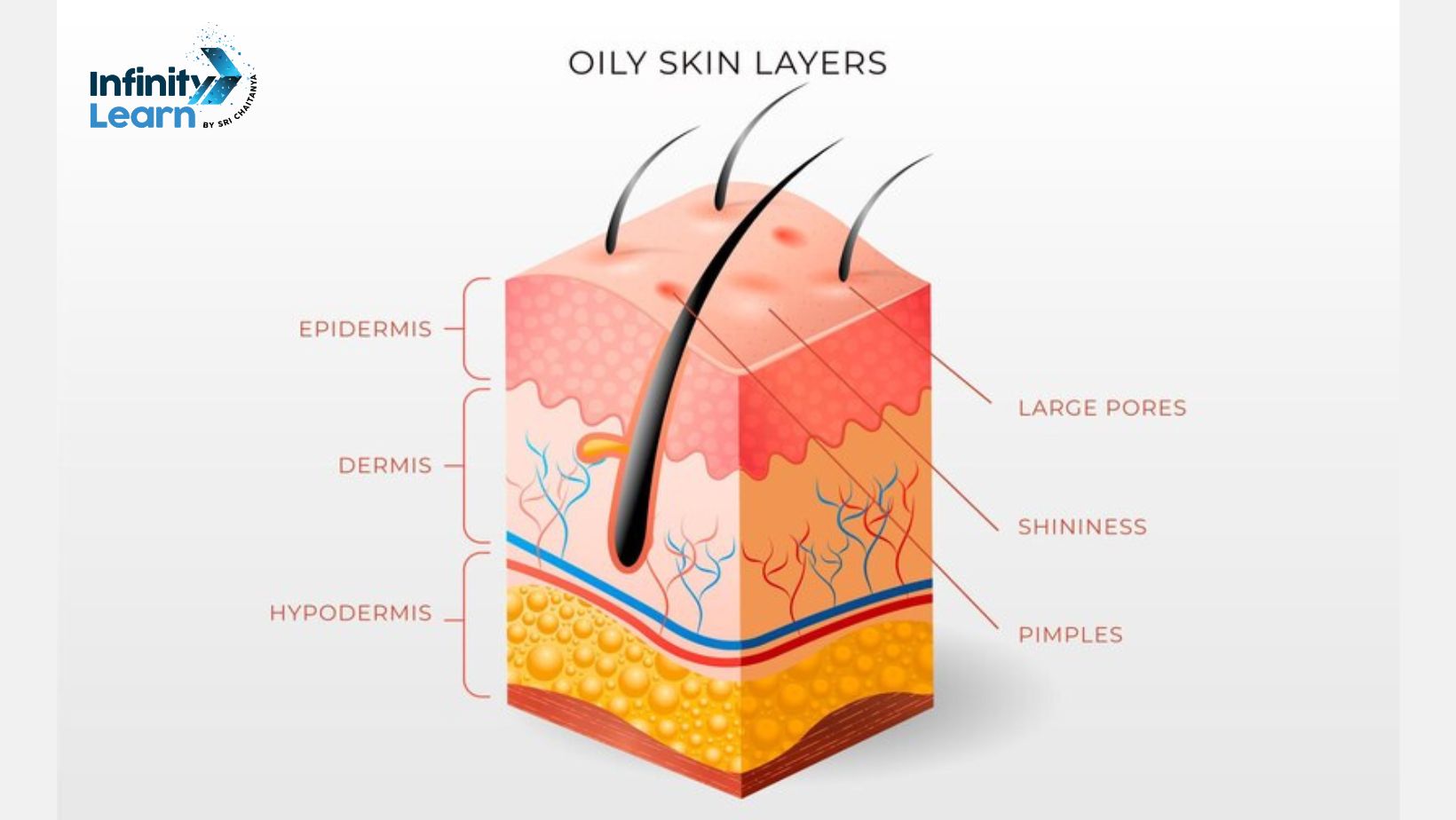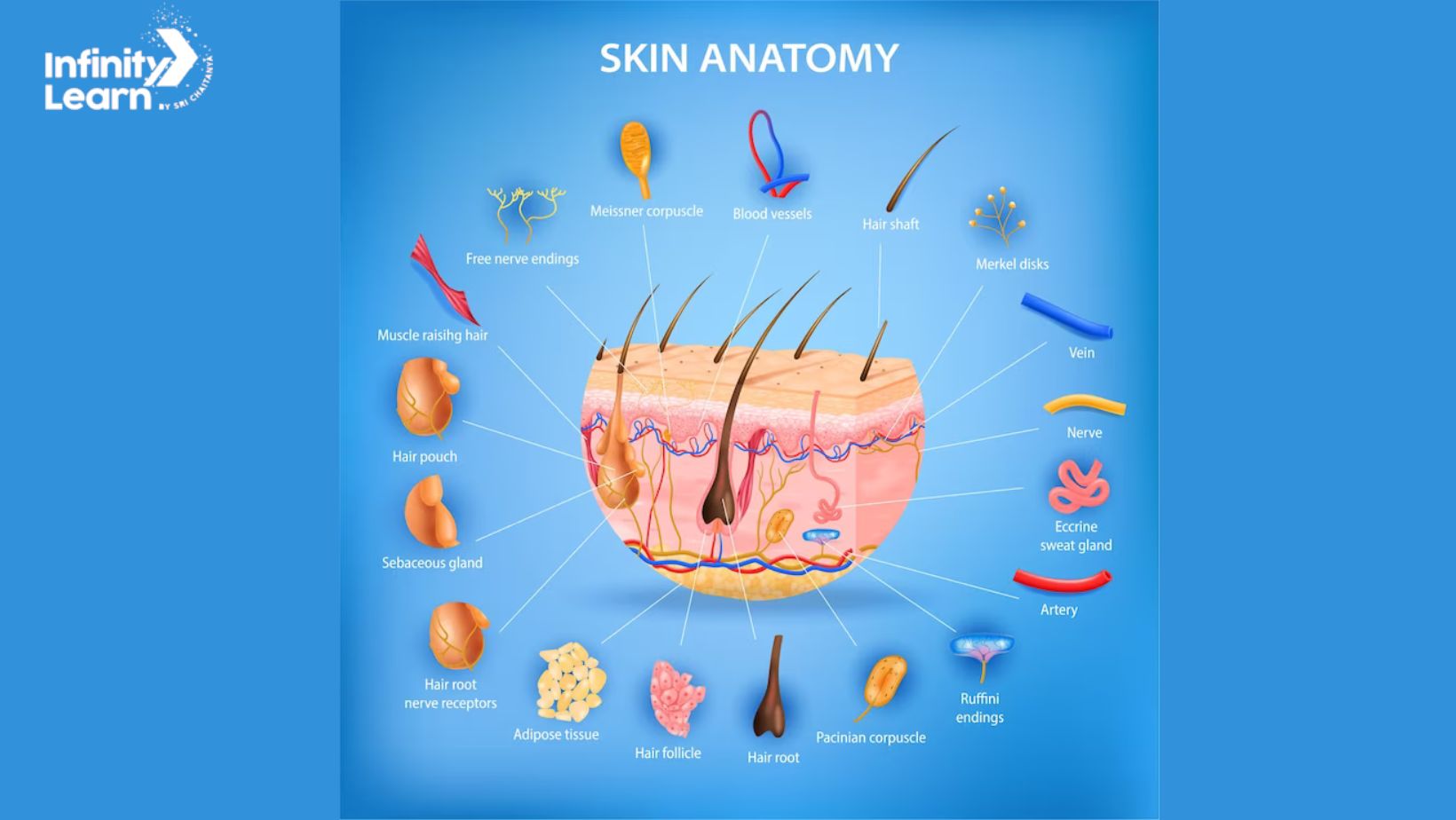Table of Contents
The skin is our body’s biggest organ and covers the whole outside part. It has three layers: the epidermis, dermis, and hypodermis, each with its unique job and makeup. This layered structure acts like a protective shield, stopping germs, sunlight, chemicals, and injuries.
It helps keep the right body temperature and controls the water our body releases. This article talks about the skin’s top layer, explaining its structure, function, how it forms, its blood supply and nerves, surgical aspects, and why it’s important for health.
Also Check: Science Topics
What is the Human Skin?
The human skin is like a protective coat covering our body. It helps us feel things from the world around us and shields us from harm. Skin has three layers: the top layer called the epidermis, which acts as the main protection; the middle layer, or dermis, which supports the epidermis; and the innermost layer, the subcutis, made of fat that gives nutrients, cushions, and insulates the body.
What are the seven most important layers of your skin?
- Stratum corneum
- Dermis
- Stratum granulosum
- Stratum spinosum
- Stratum basale
- Stratum lucidum
- Hypodermis

The skin has five layers in its outer part, known as the epidermis. There are seven layers in total, and each one is different in how it looks and what it does.
Epidermis
The epidermis is like the top layer of the skin. It does a lot of important jobs, such as shielding your body from things outside, keeping your skin moist, making new skin cells, and deciding your skin tone. Looking after your epidermis matters. You can do this by drinking lots of water, eating foods full of antioxidants, and using sunscreen with an SPF 50 regularly.
The epidermis is the thin top layer of the skin. It’s made up of three kinds of cells:
Stratum Corneum: Flat cells, the top layer that keeps shedding, are called the stratum corneum.
Basel Cell: Underneath these are basal cells, found at the bottom of the skin’s outer layer, just below the flat cells.
Melanocytes: Then, there are melanocytes, also located at the base of this outer layer. They produce melanin, which is what gives the skin its color.
Dermis
The layer beneath your skin is called the dermis. It has a protein called collagen that keeps it strong and flexible. In this layer, there are also receptors that help you feel pain and touch.
The dermis is the middle layer of the skin. The dermis contains the following layers:
- Blood vessels
- Hair follicles
- Lymph vessels
- Nerves
- Sweat glands
- Collagen bundles
- Fibroblasts
- Sebaceous glands
Skin Thickness
The skin’s thickness varies across the body, depending on its layers. For instance, the skin on our palms and the soles of our feet is the thickest. This is because it contains an additional layer called the stratum lucidum in its top layer. Interestingly, although the skin on the upper back has a thicker deeper layer, it’s still termed ‘thin skin’ because its top layer lacks the extra stratum lucidum and is thinner compared to the skin found on palms and soles.
Structure of Skin
Your skin has three main layers. The top one is called the epidermis, then comes the dermis, and underneath is the subcutaneous tissue. The epidermis protects and gives color to your skin. It has different layers depending on where it is, like five layers in thick skin and four in other places.

The dermis, below the epidermis, has connective tissue, hair roots, blood vessels, and sweat glands. It’s divided into two layers: the upper papillary dermis and the lower reticular dermis.
The skin does lots of important jobs:
Protection: It shields your body from germs, dryness, sunlight, and injuries.
Sensation: It helps you sense touch, temperature, and pain.
Mobility: Your skin lets you move easily.
Endocrine activity: It helps in making Vitamin D, important for bones.
Sweating: It releases sweat, oils, and other stuff your body doesn’t need.
Fungus: It helps your body fight off infections.
Regulation of Temperatures: It helps manage body temperature and keeps water levels steady.
Skin FAQs
What are the 10 functions of the skin?
The skin protects against infections, regulates body temperature, senses touch, pain, and pressure, stores fat, produces vitamin D, and helps with immunity, among other functions.
Why is skin used?
Skin is used as a protective barrier for the body, keeping harmful things out and helping maintain a stable environment inside.
What are the 5 parts of the skin?
The skin consists of the epidermis, dermis, hypodermis (subcutaneous tissue), sweat glands, and hair follicles.
How many layers are in my skin?
The skin has three main layers: the epidermis, dermis, and subcutaneous tissue (hypodermis).
What are the six functions of the skin?
The skin acts as a barrier, regulates temperature, provides sensation, produces vitamin D, helps with excretion, and offers protection against harmful elements.
What is the structural formula of the skin?
The structural formula of the skin involves layers: the outermost layer (epidermis), the middle layer (dermis), and the deeper layer (subcutaneous tissue).









